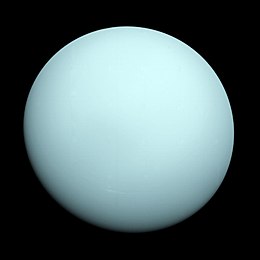34 Tauri

Uranus as a featureless disc, photographed by Voyager 2 in 1986
|
|||||||||||||
| Discovery | |||||||||||||
|---|---|---|---|---|---|---|---|---|---|---|---|---|---|
| Discovered by | William Herschel | ||||||||||||
| Discovery date | March 13, 1781 | ||||||||||||
| Designations | |||||||||||||
| Pronunciation |
|
||||||||||||
| Adjectives | Uranian | ||||||||||||
| Orbital characteristics | |||||||||||||
| Epoch J2000 | |||||||||||||
| Aphelion |
20.11 AU (3,008 Gm) |
||||||||||||
| Perihelion |
18.33 AU (2,742 Gm) |
||||||||||||
|
19.2184 AU (2,875.04 Gm) |
|||||||||||||
| Eccentricity | 0.046381 | ||||||||||||
|
|||||||||||||
| 369.66 days | |||||||||||||
|
Average orbital speed
|
6.80 km/s | ||||||||||||
| 142.238600° | |||||||||||||
| Inclination |
0.773° to ecliptic 6.48° to Sun's equator 1.02° to invariable plane |
||||||||||||
| 74.006° | |||||||||||||
| 96.998857° | |||||||||||||
| Known satellites | 27 | ||||||||||||
| Physical characteristics | |||||||||||||
|
Mean radius
|
25,362±7 km | ||||||||||||
|
Equatorial radius
|
25,559±4 km 4.007 Earths |
||||||||||||
|
Polar radius
|
24,973±20 km 3.929 Earths |
||||||||||||
| Flattening | 0.0229±0.0008 | ||||||||||||
| Circumference | 159,354.1 km | ||||||||||||
|
8.1156×109 km2 15.91 Earths |
|||||||||||||
| Volume |
6.833×1013 km3 63.086 Earths |
||||||||||||
| Mass |
(8.6810±0.0013)×1025 kg |
||||||||||||
|
Mean density
|
1.27 g/cm3 | ||||||||||||
| 0.210 | |||||||||||||
| 0.23 (estimate) | |||||||||||||
| 21.3 km/s | |||||||||||||
|
Sidereal rotation period
|
−0.71833 d (retrograde) 17 h 14 min 24 s |
||||||||||||
|
Equatorial rotation velocity
|
2.59 km/s 9,320 km/h |
||||||||||||
| 97.77° (to orbit) | |||||||||||||
|
North pole right ascension
|
17h 9m 15s 257.311° |
||||||||||||
|
North pole declination
|
−15.175° | ||||||||||||
| Albedo | 0.300 (Bond) 0.51 (geom.) |
||||||||||||
|
|||||||||||||
| 5.9 to 5.32 | |||||||||||||
| 3.3″ to 4.1″ | |||||||||||||
| Atmosphere | |||||||||||||
| 27.7 km | |||||||||||||
| Composition by volume |
(Below 1.3 bar)
Ices:
|
||||||||||||
(8.6810±0.0013)×1025 kg
14.536 Earths
(Below 1.3 bar)
Gases:
Ices:
Uranus is the seventh planet from the Sun. It has the third-largest planetary radius and fourth-largest planetary mass in the Solar System. Uranus is similar in composition to Neptune, and both have different bulk chemical composition from that of the larger gas giants Jupiter and Saturn. For this reason, scientists often classify Uranus and Neptune as "ice giants" to distinguish them from the gas giants. Uranus's atmosphere is similar to Jupiter's and Saturn's in its primary composition of hydrogen and helium, but it contains more "ices" such as water, ammonia, and methane, along with traces of other hydrocarbons. It is the coldest planetary atmosphere in the Solar System, with a minimum temperature of 49 K (−224 °C; −371 °F), and has a complex, layered cloud structure with water thought to make up the lowest clouds and methane the uppermost layer of clouds. The interior of Uranus is mainly composed of ices and rock.
Uranus is the only planet whose name is derived from a figure from Greek mythology, from the Latinised version of the Greek god of the sky Ouranos. Like the other giant planets, Uranus has a ring system, a magnetosphere, and numerous moons. The Uranian system has a unique configuration among those of the planets because its axis of rotation is tilted sideways, nearly into the plane of its solar orbit. Its north and south poles, therefore, lie where most other planets have their equators. In 1986, images from Voyager 2 showed Uranus as an almost featureless planet in visible light, without the cloud bands or storms associated with the other giant planets. Observations from Earth have shown seasonal change and increased weather activity as Uranus approached its equinox in 2007. Wind speeds can reach 250 metres per second (900 km/h; 560 mph).
...
Wikipedia
